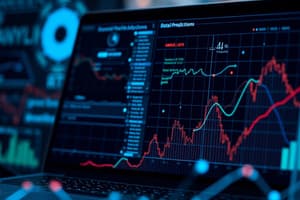Podcast
Questions and Answers
The statement includes a series of alphanumeric characters that represent encoded data.
The statement includes a series of alphanumeric characters that represent encoded data.
True (A)
The character 'f' is the first character in the provided content.
The character 'f' is the first character in the provided content.
False (B)
The content mentions the need to learn.
The content mentions the need to learn.
True (A)
The content provides clear and understandable instructions.
The content provides clear and understandable instructions.
The character sequence ends with a '=' sign.
The character sequence ends with a '=' sign.
A mapping function transforms inputs to outputs.
A mapping function transforms inputs to outputs.
Covariates are independent variables that are not influenced by other variables in a model.
Covariates are independent variables that are not influenced by other variables in a model.
Predictors and features refer to the same concept in data analysis.
Predictors and features refer to the same concept in data analysis.
Features in a modeling context only refer to qualitative data.
Features in a modeling context only refer to qualitative data.
Mapping functions can only be linear in nature.
Mapping functions can only be linear in nature.
Inputs in an analysis context are always numerical.
Inputs in an analysis context are always numerical.
In data science, outputs are typically the results we wish to predict or estimate.
In data science, outputs are typically the results we wish to predict or estimate.
A predictor variable can influence the outcome variable in a regression analysis.
A predictor variable can influence the outcome variable in a regression analysis.
The primary purpose of predictors is to obscure the effects of other variables.
The primary purpose of predictors is to obscure the effects of other variables.
Mapping functions are irrelevant when dealing with complex data sets.
Mapping functions are irrelevant when dealing with complex data sets.
Data integration aims to combine data from heterogeneous sources into a single coherent data store.
Data integration aims to combine data from heterogeneous sources into a single coherent data store.
The percentage of time spent on cleaning and organizing data is 57%.
The percentage of time spent on cleaning and organizing data is 57%.
Data integration does not consider disparate data sources.
Data integration does not consider disparate data sources.
Mining data for patterns accounts for 3% of the total time in the outlined processes.
Mining data for patterns accounts for 3% of the total time in the outlined processes.
Refining algorithms takes up 4% of the data processing time.
Refining algorithms takes up 4% of the data processing time.
Data integration provides inconsistent access to data across various subjects.
Data integration provides inconsistent access to data across various subjects.
Collecting data sets comprises 21% of data handling tasks.
Collecting data sets comprises 21% of data handling tasks.
The combined time allocated for building training sets and refining algorithms is 14%.
The combined time allocated for building training sets and refining algorithms is 14%.
Supervised learning is a form of machine learning that relies on inputs and outputs.
Supervised learning is a form of machine learning that relies on inputs and outputs.
In supervised learning, the term 'label' refers to the features of the data.
In supervised learning, the term 'label' refers to the features of the data.
Supervised learning requires data that includes both covariates and labels.
Supervised learning requires data that includes both covariates and labels.
The primary goal of supervised learning is to process unlabelled data.
The primary goal of supervised learning is to process unlabelled data.
A mapping function is unnecessary in supervised learning frameworks.
A mapping function is unnecessary in supervised learning frameworks.
Supervised learning algorithms do not rely on any output information.
Supervised learning algorithms do not rely on any output information.
Covariates in supervised learning refer to independent variables used for prediction.
Covariates in supervised learning refer to independent variables used for prediction.
In supervised learning, ambiguity is encouraged by using a mix of labeled and unlabeled data.
In supervised learning, ambiguity is encouraged by using a mix of labeled and unlabeled data.
Supervised learning is the rarest form of machine learning.
Supervised learning is the rarest form of machine learning.
The response variable in supervised learning is sometimes unable to be predicted accurately.
The response variable in supervised learning is sometimes unable to be predicted accurately.
Output in supervised learning can exist in various forms such as continuous or categorical.
Output in supervised learning can exist in various forms such as continuous or categorical.
Features in supervised learning are always uncorrelated.
Features in supervised learning are always uncorrelated.
Supervised learning typically deals with high-dimensional data.
Supervised learning typically deals with high-dimensional data.
The term 'predictors' in supervised learning can refer to the same entities as covariates.
The term 'predictors' in supervised learning can refer to the same entities as covariates.
In supervised learning, having a larger dataset guarantees a perfect mapping function.
In supervised learning, having a larger dataset guarantees a perfect mapping function.
In supervised learning, a mapping function is learned from input to output.
In supervised learning, a mapping function is learned from input to output.
The parameters of the model in supervised learning are referred to as x.
The parameters of the model in supervised learning are referred to as x.
The output values predicted by the model are represented as yp.
The output values predicted by the model are represented as yp.
Supervised learning does not require labeled data.
Supervised learning does not require labeled data.
Linear regression is a type of supervised learning algorithm.
Linear regression is a type of supervised learning algorithm.
In supervised learning, the objective is to minimize the difference between predicted values and actual values.
In supervised learning, the objective is to minimize the difference between predicted values and actual values.
The data used in supervised learning includes both inputs and outputs.
The data used in supervised learning includes both inputs and outputs.
The notation yp = f (⌦, x) indicates a function that predicts input from the output.
The notation yp = f (⌦, x) indicates a function that predicts input from the output.
In supervised learning, the model parameters are typically fixed after training.
In supervised learning, the model parameters are typically fixed after training.
The function f in the equation yp = f (⌦, x) can be a linear or a non-linear function.
The function f in the equation yp = f (⌦, x) can be a linear or a non-linear function.
In supervised learning, the variables x and yp can represent non-numerical data.
In supervised learning, the variables x and yp can represent non-numerical data.
The variables x and yp are always multidimensional in supervised learning.
The variables x and yp are always multidimensional in supervised learning.
Supervised learning is primarily used for classification and regression tasks.
Supervised learning is primarily used for classification and regression tasks.
Customer data can be utilized as input when training a supervised learning model.
Customer data can be utilized as input when training a supervised learning model.
A mapping function converts inputs to outputs.
A mapping function converts inputs to outputs.
Features are also known as labels in a mapping function.
Features are also known as labels in a mapping function.
Covariates are another term for outputs in a mapping function.
Covariates are another term for outputs in a mapping function.
Predictors can also be called covariates.
Predictors can also be called covariates.
In the context of machine learning, the term 'label' refers to the input data.
In the context of machine learning, the term 'label' refers to the input data.
A mapping function can involve both supervised and unsupervised learning.
A mapping function can involve both supervised and unsupervised learning.
In a mapping function, outputs can be solely determined by a constant value.
In a mapping function, outputs can be solely determined by a constant value.
Mapping functions can only output numerical values.
Mapping functions can only output numerical values.
The target in a mapping function is the same as the response.
The target in a mapping function is the same as the response.
Data labels must always be numerical in nature.
Data labels must always be numerical in nature.
In statistical modeling, predictors help explain the variation in the output.
In statistical modeling, predictors help explain the variation in the output.
A well-defined mapping function should have a consistent relationship between the inputs and outputs.
A well-defined mapping function should have a consistent relationship between the inputs and outputs.
Examples are unnecessary when explaining mapping functions.
Examples are unnecessary when explaining mapping functions.
A mapping function may use more than one input feature to determine an output.
A mapping function may use more than one input feature to determine an output.
Flashcards
Mapping Function
Mapping Function
A function that transforms input data into a desired output.
Inputs
Inputs
Data points or variables used as input to a machine learning model. These can be features, covariates, or predictors.
Output
Output
The desired output or result predicted by a machine learning model. This can be a label, target, or response.
Supervised Learning
Supervised Learning
Signup and view all the flashcards
Data Integration
Data Integration
Signup and view all the flashcards
Why Data Integration?
Why Data Integration?
Signup and view all the flashcards
Heterogeneous Data Sources
Heterogeneous Data Sources
Signup and view all the flashcards
Consistent Data Access
Consistent Data Access
Signup and view all the flashcards
Data Consistency
Data Consistency
Signup and view all the flashcards
Business Insights
Business Insights
Signup and view all the flashcards
Data Quality Enhancement
Data Quality Enhancement
Signup and view all the flashcards
Data Utilization
Data Utilization
Signup and view all the flashcards
What is a mapping function?
What is a mapping function?
Signup and view all the flashcards
What are inputs in machine learning?
What are inputs in machine learning?
Signup and view all the flashcards
What is the output of a machine learning model?
What is the output of a machine learning model?
Signup and view all the flashcards
What are features, covariates, and predictors in machine learning?
What are features, covariates, and predictors in machine learning?
Signup and view all the flashcards
What are outputs in machine learning?
What are outputs in machine learning?
Signup and view all the flashcards
What is supervised learning?
What is supervised learning?
Signup and view all the flashcards
What is unsupervised learning?
What is unsupervised learning?
Signup and view all the flashcards
Training Data
Training Data
Signup and view all the flashcards
Test Data
Test Data
Signup and view all the flashcards
Model Training
Model Training
Signup and view all the flashcards
Model Evaluation
Model Evaluation
Signup and view all the flashcards
Model Optimization
Model Optimization
Signup and view all the flashcards
Generalization
Generalization
Signup and view all the flashcards
Model Accuracy
Model Accuracy
Signup and view all the flashcards
Model Prediction
Model Prediction
Signup and view all the flashcards
Predictors
Predictors
Signup and view all the flashcards
Target
Target
Signup and view all the flashcards
Model Performance
Model Performance
Signup and view all the flashcards
Supervised Learning: What's the Goal?
Supervised Learning: What's the Goal?
Signup and view all the flashcards
Inputs: What Does the Model Use?
Inputs: What Does the Model Use?
Signup and view all the flashcards
Outputs: What Does the Model Produce?
Outputs: What Does the Model Produce?
Signup and view all the flashcards
Parameters: How Does the Model Learn?
Parameters: How Does the Model Learn?
Signup and view all the flashcards
Training: How Does the Model Improve?
Training: How Does the Model Improve?
Signup and view all the flashcards
Prediction: What Does the Model Do After Training?
Prediction: What Does the Model Do After Training?
Signup and view all the flashcards
Linear Regression: What Kind of Relationship?
Linear Regression: What Kind of Relationship?
Signup and view all the flashcards
Evaluation: How Good is the Model?
Evaluation: How Good is the Model?
Signup and view all the flashcards
Metrics: How Do We Measure Success?
Metrics: How Do We Measure Success?
Signup and view all the flashcards
Tuning: How Do We Fine-Tune the Model?
Tuning: How Do We Fine-Tune the Model?
Signup and view all the flashcards
Deployment: How Do We Use the Model in Practice?
Deployment: How Do We Use the Model in Practice?
Signup and view all the flashcards
Data Collection: Where Does the Model Learn From?
Data Collection: Where Does the Model Learn From?
Signup and view all the flashcards
Data Preparation: How Do We Make the Data Usable?
Data Preparation: How Do We Make the Data Usable?
Signup and view all the flashcards
Mapping Function: What Is the Model's Purpose?
Mapping Function: What Is the Model's Purpose?
Signup and view all the flashcards
Study Notes
Learning from Data Lecture 2
- Topics covered in the lecture include Data Integration, Learning from Data, Supervised Learning, and Linear Regression.
- Data scientists spend a significant amount of time cleaning and organizing data (60%), followed by collecting data sets (19%).
- Building training sets (3%), mining data for patterns (9%), and refining algorithms (4%) are other common tasks.
- Data Integration is combining data from heterogeneous sources to a single coherent data store.
- It provides consistent access and delivery for different subject types and data structures.
- Data sources are often disparate and siloed, requiring access across various sub-systems (e.g., hardware, software applications, operating systems).
- Data Integration: Strategies include common user interfaces, middleware data integration, application-based integration, uniform data access, and common data storage (data warehouses).
- Supervised learning is the most common form of machine learning.
- The task is to learn a mapping function (f) from inputs (x ∈ X) to outputs (y ∈ Y).
- Inputs are also referred to as features, covariates, or predictors.
- Outputs are also referred to as labels, target, or response variables.
- Examples of supervised learning include image recognition (e.g., identifying cats versus dogs), and predicting movie revenue based on budget.
- Unsupervised learning focuses on finding patterns within data without predefined labels.
- Examples include clustering (grouping data points) and dimensionality reduction (reducing the number of variables to extract essential information).
- There is an example of electricity usage patterns across houses over time which can be clustered in different groups.
- Types of Supervised Learning: Regression (quantitative response), and Classification (qualitative response).
- Regression models are the foundation for modeling any continuous target.
- Examples of continuous variables include loss, revenue, number of years.
- Classification involves identifying which set of categories an observation belongs to.
- An example includes identifying different types of iris flowers (setosa, versicolor, and virginica).
- Linear Regression: A simple linear regression model has two parameters (β0 and β1).
- β0 is the Y-intercept and β1 is the slope of the regression line.
- The loss function (J(y, yp)) quantitatively measures the quality of predictions, aiming at minimizing differences between predicted and actual values.
Studying That Suits You
Use AI to generate personalized quizzes and flashcards to suit your learning preferences.




